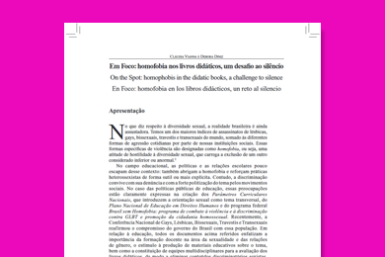
Regarding sexual diversity, the current Brazilian reality is still frightening. We have one of the highest murder rates of lesbians, gays, bisexuals, transvestites, and transsexuals in the world, added to the different forms of daily aggression by our institutions. These specific forms of violence are designated as homophobia, that is, an attitude of hostility to sexual diversity, which entails the exclusion of someone seen as inferior or abnormal. In the educational field, school policies and relations hardly escape this context: they also shelter homophobia and reinforce heterosexist practices in a subtle or more explicit way. However, discrimination coexists with its denunciation and with the strong politicization of the issue by social movements. In the case of public education policies, these concerns are clearly expressed in the creation of the National Curriculum Parameters (which introduce sexual orientation as a cross-cutting theme), the National Plan for Human Rights Education and the federal program Brazil without Homophobia: program to combat violence and discrimination against GLBT and promotion of homosexual citizenship. Recently, the National Conference of Gays, Lesbians, Bisexuals, Transvestites and Transsexuals reaffirmed the Brazilian government’s commitment to this population. Regarding education, all these documents emphasize the importance of teacher training in the area of sexuality and gender relations, encouraging the production of educational materials on the subject, as well as the constitution of multidisciplinary teams for the evaluation of textbooks, in order to eliminate discriminatory sexist, heterosexist, and homophobic content in teaching materials.